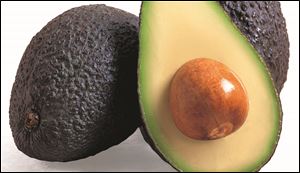
Avocado season: Essential ingredient for Cinco de Mayo
4/20/2009
BRE154474 D
Avocados are a common ingredient in Mexican and Latin cooking. With only two weeks until Cinco de Mayo celebrations on May 5, it s time to get your fill. The California avocado season runs from May through August
Ninety percent of the nation s avocado crop is grown in California by more than 6,000 farmers. The Hass variety accounts for 95 percent of the total crop in California; these are darker green than the Florida avocado, with bumpier skin and very smooth fruit.
Chicken and Avocado Skillet Chilaquiles, a recipe from restaurateurs Mary Sue Milliken and Susan Feniger on behalf of the California Avocado Commission, is a modern twist on a traditional favorite. It s a dish served during lunchtime in their establishments, the Border Grill restaurants in Santa Monica, Calif., and Las Vegas, as well as Ciudad in downtown Los Angeles. Their cooking style is heavily influenced by the Mexican and South American cultures.
According to The New Food Lover s Companion, chilaquiles (pronounced chee-lah-KEE-lehs) is a Mexican entree invented to use leftovers. It consists of corn tortilla strips sauteed with other foods such as shredded chicken or beef, mild green chiles, cheese, and chorizo. It may also be layered like lasagna and baked. In this recipe, avocado is added to the mix.
Here s a new way to make enchiladas. Avocado Enchiladas Frescas (from Milliken and Feniger) made with fresh ingredients, includes Avocado Tomatillo Salsa and Enchilada Sauce; the enchiladas are made with corn tortillas filled with an avocado-and-cheese mixture. The tomatillo resembles a small green tomato in size, shape, and appearance, except it has a thin parchment-like covering that is removed to dice the fruit. The recipe uses Mexican cheeses such as panela cheese, Cotija, and manchego.
All of these recipes make for great Cinco de Mayo celebrations.
One of the characteristics of the Mexican kitchen is that many recipes have an assembly of ingredients and use up leftovers, writes Lourdes Castro in Simply Mexican (Ten Speed Press, $24.95). Among the recipes is Stacked Chicken Tostadas made up of two tostadas. The first is prepared with poached chicken and toppings such as shredded lettuce, marinated onion, black beans, crumbles of queso fresco, and avocado-tomato salad drizzled with crema and topped with a second tostada similarly topped.
When using avocados in recipes, it s important to buy fruit that will be ripe on the day you want to use it. Sometimes avocados are too ripe in the supermarket, or too green.
The easiest way to tell if an avocado is ready for use is to gently squeeze the fruit in the palm of your hand. Ripe, ready-to-eat fruit will yield to gentle pressure.
To ripen an avocado, place it in a paper bag with an apple for two to three days at room temperature, according to the California Avocado Commission. Apples accelerate the process by giving off ethylene, a ripening agent.
The Hass variety will generally turn dark green to purplish-black as it ripens. Other varieties retain their light-green skin even when ripe. (Other California-grown varieties are Bacon, Fuerte, Gwen, Lamb Hass, Pinkerton, Reed, and Zutano.)
Ripe, uncut fruit can be stored in the refrigerator for two to three days. To store cut fruit, sprinkle with lemon juice, lime juice, or white vinegar and place in an air-tight container in the refrigerator.
If you have too many fresh, ripe avocados, freeze them. Pureed avocados freeze well in sealable plastic bags (press down to get air out to preserve the color). Pureed avocado can be used on sandwiches and in dips. Use frozen avocado puree within four to five months.
Mashed avocado makes a wonderful guacamole dip when paired with lemon or lime juice and seasonings such as chili powder and red pepper. Sometimes chopped tomato, green onion, and cilantro are added. It must be covered closely and tightly to prevent discoloration.
Avocado can be sliced to top salads, burgers, and pizza. It can be used in hot tortilla soup or gazpacho (cold soup) or seafood appetizers. Include avocado in breakfast omelets or Eggs Benedict.
To pit avocados, halve first by slicing lengthwise from top to bottom and twist to separate. Then lightly chop the pit with a chef s knife and give it a sideways twist, writes Mark Miller in Tacos (Ten Speed Press, $21.95). The avocado pit will release from its flesh.
To slice or dice, halve and pit the avocados, then slice or cube the flesh in the peel and scoop out with a spoon.
One-fifth of a medium avocado (1 ounce) has 50 calories. They are sodium-free and cholesterol-free. Due to their mono and polyunsaturated fat content, they are a substitution for foods rich in saturated fat. The avocado is the only fruit that has monounsaturated fat.